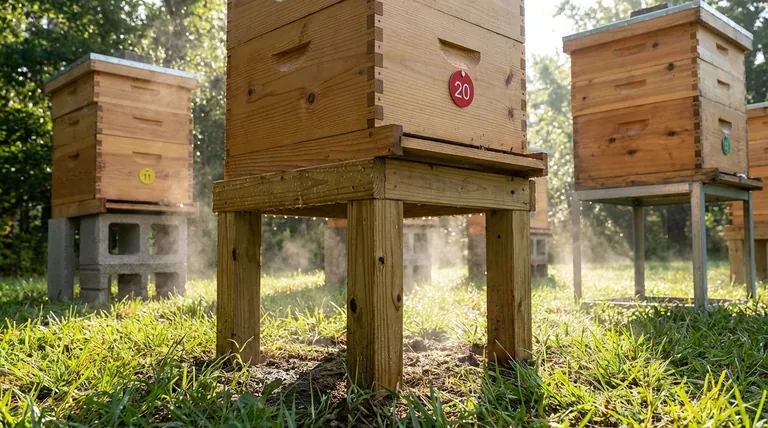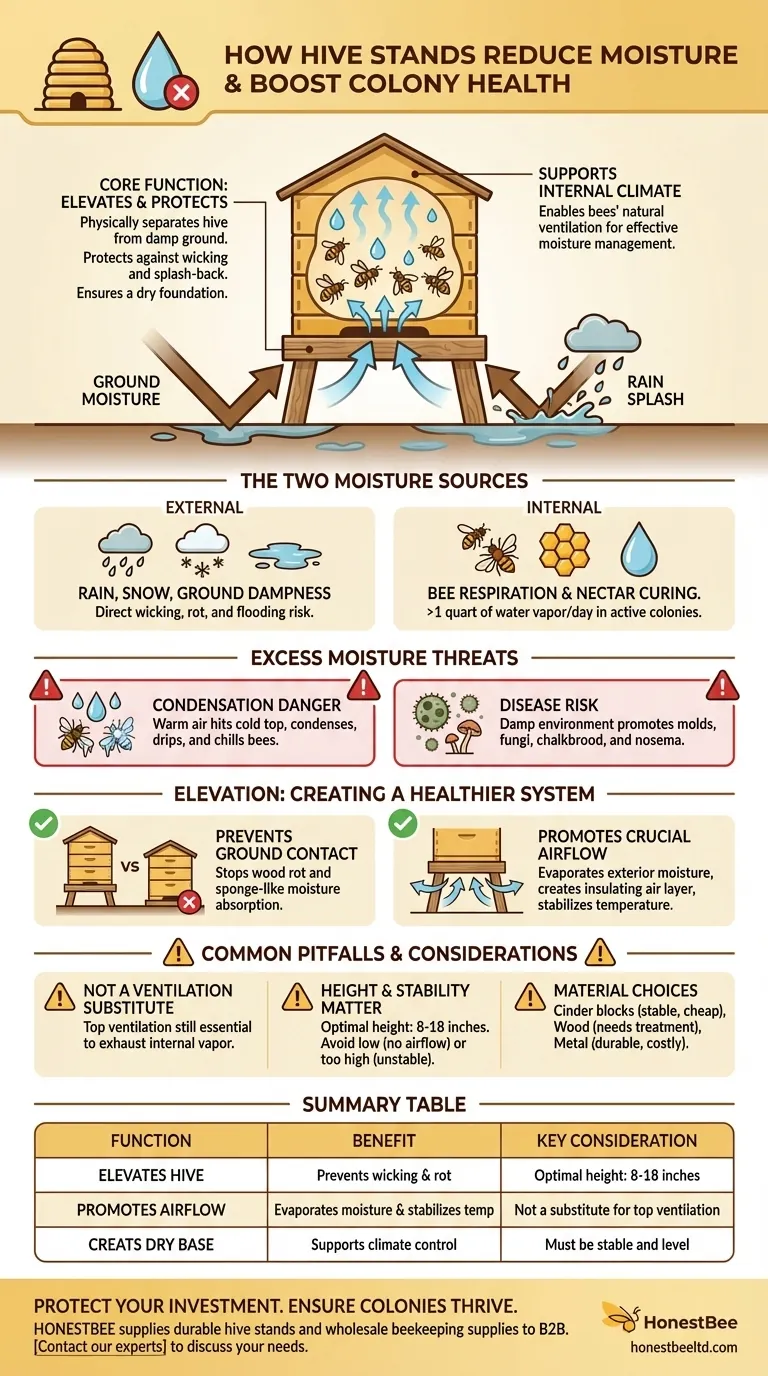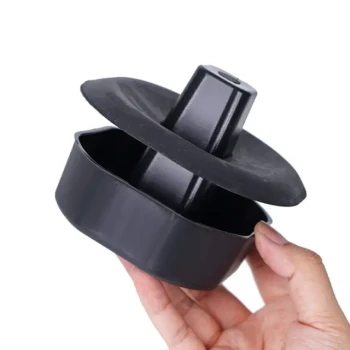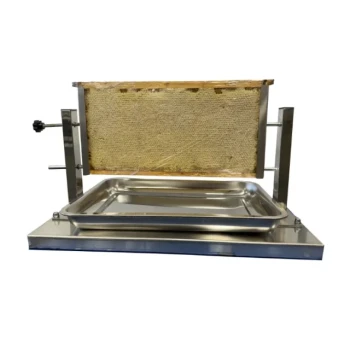At its core, a hive stand reduces moisture by physically elevating the hive off the damp ground. This separation prevents ground moisture from wicking into the wooden bottom board and protects the hive entrance from rain splash-back. By ensuring the base of the hive remains dry, a stand provides a crucial foundation for the colony's own efforts to manage its internal climate.
A hive stand's primary role is not just to block external water, but to create the dry, insulated base and airflow necessary for the bees' own ventilation system to function effectively. It’s a tool for managing the hive's internal climate, not simply a barrier against the elements.

The Two Sources of Hive Moisture
To understand the role of a hive stand, you must first recognize that moisture comes from both outside and inside the hive.
External Moisture
This is the most obvious source. Rain, melting snow, and persistent ground dampness can all introduce water into the hive. A hive placed directly on the ground is highly susceptible to rot and moisture wicking directly into the bottom board.
Internal Moisture
Bees themselves produce a significant amount of water vapor through respiration and the process of curing nectar into honey. A large, active colony can release over a quart of water vapor into the hive's air every day.
Why Excess Moisture is a Critical Threat
While bees need some humidity, excessive, uncontrolled moisture is one of the greatest threats to a colony, especially during winter.
The Danger of Condensation
Warm, moist air produced by the bee cluster rises. When it hits the cold inner cover or top of the hive, it condenses into water droplets. This cold water can then drip back down onto the bees, chilling and killing them.
The Risk of Disease
A persistently damp hive environment is the perfect breeding ground for various pathogens. Molds and fungi can flourish, and the stress of a damp, cold environment can make the colony more susceptible to diseases like chalkbrood and nosema.
How Elevation Creates a Healthier System
A hive stand directly counteracts moisture problems by fundamentally changing the hive's relationship with its environment.
Preventing Ground Contact
The most direct benefit is creating a physical barrier between the hive's wooden bottom board and the damp earth. This single action dramatically reduces the risk of wood rot and prevents the hive from acting like a sponge for ground moisture.
Promoting Crucial Airflow
By lifting the hive, a stand allows air to circulate freely underneath it. This constant airflow helps to evaporate any moisture on the exterior of the bottom board, keeping it dry and providing a layer of insulating air that helps stabilize the hive's internal temperature.
Common Pitfalls and Considerations
While beneficial, a hive stand is only one part of a complete moisture management strategy. Relying on it alone is a common mistake.
A Stand Is Not a Substitute for Ventilation
A hive stand helps keep the bottom dry, but it does nothing to release the water vapor the bees produce internally. Proper top ventilation is still essential to allow the warm, moist air to escape before it can condense and drip down.
Height and Stability Matter
A stand that is too low may not provide adequate airflow, while one that is too high can become unstable in strong winds. A height of 8 to 18 inches is generally considered a good balance between ergonomic access, airflow, and stability.
Material Choices Have Consequences
Simple cinder blocks are effective and inexpensive but can be less stable on uneven ground. Wooden stands are common but require treatment to prevent rot. Metal stands offer longevity but are often the most expensive option.
Making the Right Choice for Your Apiary
Your approach should be guided by your specific environmental challenges and goals.
- If your primary focus is preventing winter losses: View the hive stand as the essential first step in a system that must also include an upper entrance or ventilation port to exhaust moisture.
- If your primary focus is reducing disease and mold: Ensure your stand provides enough height for excellent airflow beneath the bottom board, as this actively works to keep the hive's foundation dry.
- If your primary focus is cost and simplicity: Simple, level cinder blocks work well, but always ensure they create a stable platform that won't shift or wobble.
Ultimately, a proper hive stand empowers the colony to maintain the dry, healthy internal environment it needs to thrive.
Summary Table:
| Function | Benefit | Key Consideration |
|---|---|---|
| Elevates Hive | Prevents ground moisture wicking & rot | Optimal height: 8-18 inches |
| Promotes Airflow | Evaporates moisture & stabilizes temperature | Not a substitute for top ventilation |
| Creates Dry Base | Supports bees' internal climate control | Must be stable and level |
Protect your investment and ensure your colonies thrive. HONESTBEE supplies durable, stable hive stands and a full range of beekeeping supplies to commercial apiaries and distributors. Our wholesale-focused operations provide the reliable equipment you need to manage hive moisture effectively and maximize colony health. Contact our experts today to discuss your apiary's needs and request a wholesale quote.
Visual Guide

Related Products
- Professional Engraved Round Hive Number Tags for Beekeeping
- Plastic Bee Hive Stand for Beekeeping
- Metal Hive Feet Bee Hive Stand for Ant Protection
- Professional Ant-Proof Beehive Stand with Integrated Moat for Beekeeping
- Metal Bee Hive Stand Bee Box Stand for Beekeeping
People Also Ask
- What maintenance is required for hive straps? A Guide to Cam Buckle vs. Ratchet Strap Care
- Why should beekeepers consider using hive stands? Protect Your Hives and Your Back
- What is the purpose of a hive stand, and why is it beneficial? Elevate Your Hive for Colony Health and Beekeeper Comfort
- Why are Posca pens commonly used for marking queen bees? The Safest, Most Durable Method for Beekeepers
- Do I need a hive stand? Essential for Bee Health & Easier Beekeeping



















